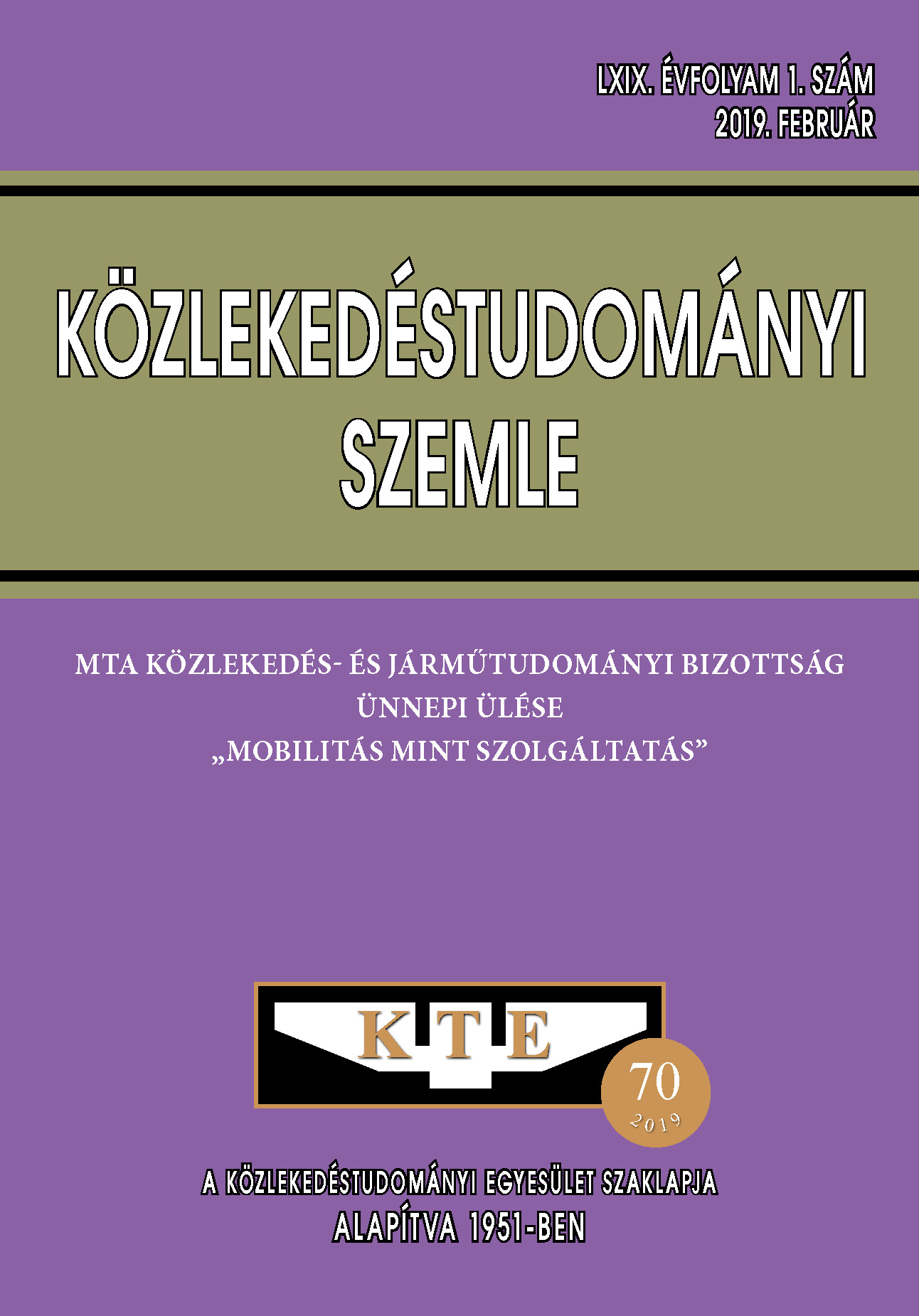Az autonóm járművek forgalmi hatásai: a jármű- és forgalomirányítás kihívásai
Absztrakt
Az autonóm járművek fejlesztése nemcsak az autógyártóknak jelent óriási feladatot, hanem a közlekedésmérnökök számára is új kihívásokat támaszt. Amikor az autonóm járművek nagy arányban jelennek majd meg a közúton, az eddig alkalmazott forgalommodellezési és közlekedési irányítási módszerek is módosításra szorulnak. Továbbá fontos kiemelni a mikroszkopikus forgalomszimuláció alkalmazási lehetőségeit a vezető nélküli járművek fejlesztési és tesztelési folyamataiban, amelyeknek új feladatait tekintjük át közlekedésmérnöki
szemszögből.
Hivatkozások
SAE International (2016): Taxonomy and Definitions for Terms Related to Driving Automation Systems for On-Road Motor Vehicles, J3016_201609, http://standards.sae.org/j3016_201401
Zöldy M. (2019): Legal Barriers of Utilization of Autonomous Vehicles as Part of Green Mobility. In: Burnete N.,
Varga B. (eds) Proceedings of the 4th International Congress of Automotive and Transport Engineering (AMMA 2018). AMMA2018 2018. Proceedings in Automotive Engineering. Springer, Cham
Fagnant, D.J., Kockelman, K.M. (2015): Preparing a nation for autonomous vehicles: opportunities, barriers and policy recommendations. Transportation Research Part A: Policy and Practice, 77, 167-181., DOi: http://doi.org/gc4n5r
Milakis, D., Snelder, M., Van Arem, B., Van Wee, B, Correia, G. (2017): Development of automated vehicles in
the Netherlands: scenarios for 2030 and 2050, European Journal of Transport and Infrastructure Research, EJTIR, 17(1), 63-85. ISSN: 1567-7141, http://tlo.tbm.tudelft.nl/ejtir
Williams, J. C., Mahmassani, H. S., Iani, S. and Herman, R. (1987): Urban traffic network flow models, Transportation Research Record 1112, 78–88
Csikós, A., Tettamanti, T. and Varga, I. (2015): Macroscopic modeling and control of emission in urban road
trafficnetworks,Transport 30(2), 152-161. DOI: http://doi.org/cxmb
Krajzewicz, D., Erdmann, J., Behrisch, M. and Bieker, L. (2012): Recent Development and Applications of SUMO - Simulation of Urban MObility. International Journal On Advances in Systems and Measurements, 5 (3&4):128-138
Geroliminis N., Daganzo C. F. Existence of urban-scale macroscopic fundamental diagrams: Some experimental findings. Transportation Research Part B: Methodological 2008, 42(9):759–770. DOI: http://doi.org/dzfcbb
Luspay T., Tettamanti T., Varga I.: Forgalomirányítás, Közúti járműforgalom modellezése és irányítása (2011): ISBN 978-963-279-665-9, Typotex Kiadó, Budapest
Wegener, A., Piórkowski, M., Raya, M. Hellbrück, H., Fischer, S. and Hubaux, J.-P. (2008): TraCI: an interface for coupling road traffic and network simulators. In Proceedings of the 11th communications and networking simulation symposium (CNS '08). ACM, New York, NY, USA, 155-163. DOI: http://doi.org/c44qw8
Krauss S. (1998): Microscopic Modeling of Traffic Flow: Investigation of Collision Free Vehicle Dynamics. Ph.D. thesis, Universität zu Köln
Kudarauskas, N. (2007): Analysis of emergency braking of a vehicle, Transport 22(3), 154–159.
Atkins Ltd. (2016): Research on the impacts of connected and autonomous vehicles (cavs) on traffic flow, Technical report, Department for Transport
Szalay Zs., Nyerges A., Hamar Z., Hesz M. (2017): Technical specification methodology for an automotive proving ground dedicated to connected and automated vehicles, Periodica Polytechnica ser. Transp. Eng. 45:(3) pp. 168-174. DOI: http://doi.org/cxk3
Az elektronikusan megjelenő cikkek nyílt hozzáféréssel rendelkeznek (OJS), online ingyenesen elérhetők és letölthetők. A cikkek szerzőit nem terheli megjelentetési vagy kiadási költség (APC). Felhasználóknak joguk van a cikkek olvasására, letöltésére, másolására, kinyomtatására, valamint azokban való keresésre, vagy a teljes szöveg linkkel történő megosztására.
A szerzőknek nyilatkozniuk kell arról, hogy beadványukat korábban nem tették közzé más folyóiratban, a pénzügyi támogatás feltüntetésre került és a hivatkozások listája teljes és pontos, beleértve az URL-ek és a DOI-k specifikációját is (ha rendelkezésre állnak). A cikktervezet beadásakor minden szerző jóváhagyja a benyújtott változatot. A szerzők garantálják, hogy a cikk az ő eredeti művük. A szerzők kötelesek részt venni a szakértői értékelés folyamatában, követni a bírálók tanácsait, betartani az előírt határidőket, és amennyiben előfordulnak, kötelesek visszavonni a benyújtást vagy kijavítani a hibákat.
Minden beadott cikket szakértői értékelés alá kerül, ahol a szerkesztők független értékelést kérnek legalább egy szakértőtől, ügyelve arra, hogy a bíráló(k)nak ne legyen összeférhetetlensége a szerzőkkel. A végső döntést a főszerkesztő hozza meg, aki figyelembe veszi az értékeléseket és a szerkesztők javaslatait. A szerkesztők és a lektorok bizalmasan kezelik a beadványt.
A kiadó és a szerkesztők elkötelezettek a magas etikai normák betartása mellett, és megakadályozzák azokat a publikációkat, amelyekben kutatási visszaélés történt. Az ilyen etikai kérdésekben a COPE irányelveit követik.
A szerzők fenntartják a szerzői jogokat, és megadják a folyóiratnak az első közzétételi jogot a Creative Commons Licenc alapján (https://creativecommons.org/licenses/by-nc-nd/4.0), amely lehetővé teszi mások számára, hogy megosszák a művet, elismerve a mű szerzőségét és a folyóiratban való első közzétételt.
A folyóirat archiválja az összes megjelent cikket, és a folyóirat tulajdonosa, a Közlekedéstudományi Egyesület továbbra is üzemelteti az adatbázist abban az esetben is, ha a folyóirat kiadása megszűnik.















